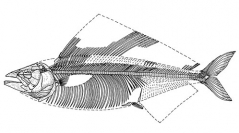

 Geodiversitas
26 (1) - Pages 89-113
Geodiversitas
26 (1) - Pages 89-113The study of the osteology of "Bananogmius" evolutus (Cope, 1877) has showed that this species does not share the two typical autapomorphies of the genus Bananogmius Whitley, 1940 (i.e. the long sharp ventro-posterior process of the antorbital and the toothless ectopterygoid), and so it can not be referred to it. It appears also different from this genus by numerous other characters: the low neurocranium, the long and sharp mesethmoid, the reduced lateral ethmoid, the small orbitosphenoid, the incomplete interorbital septum, the reduced fifth infraorbital, the premaxilla much longer than broad, the preoperculum with a short ventral branch, the reduced pelvic girdle and fins, the hemaxanal complex of type 3, the large lateral processes on the posterior dorsal radials, the numerous vertebrae, the loss of the preural 1 hemal arch, the loss of the sixth hypural and the presence of dermal scutes on the back. By its dermobasihyal pentagon-shaped, "B." evolutus clearly belongs to the genus Pentanogmius Taverne, 2000, a taxon still very imperfectly known but of which the only autapomorphy is precisely to have a pentagonal toothed dermobasihyal. Within the Tselfatiiformes, Pentanogmius is a derived genus.
Teleostei, Tselfatiiformes, Pentanogmius evolutus n. comb., marine Upper Cretaceous, United States, osteology, phylogenetic relationships